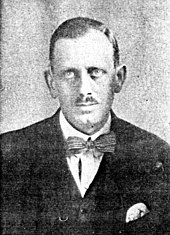Friedrich Wilhelm Virck
Friedrich Wilhelm Virck (* 1882 in Malchow , † November 29, 1926 in Lübeck ) was a German architect and construction clerk , he last worked as a senior building officer in Lübeck.
Life
After studying at the Technical University of Darmstadt , the Technical University of Munich and the Technical University (Berlin-) Charlottenburg , he first worked in an architecture office and between 1912 and 1919 in the Prussian building administration, where he was involved in buildings in Köslin and Berlin . In 1913 Virck won the architectural competition for a Moltketurm on the Ruhner Berg near Parchim, but this was not carried out because of the outbreak of war a year later. In 1919 he joined the Lübeck building department under Johannes Baltzer , where he took over his duties after Carl Mühlenpfordt left . Before the inflation he was mainly concerned with planning the settlements. Together with the garden architect Harry Maasz , he drafted plans for the settlements in Dornbreite, on Gärtnergasse and on Kücknitzer Mühlenteich, which were only implemented very imperfectly due to inflation and were also implemented after the Second World War . B. in the case of the Dornbreite settlement were further disfigured by building over the central Johannes-Baltzer-Platz.
Its individual buildings, the small guard building at the southern end of the Parade (1923), the trade school on the corner of Parade and Dankwartsgrube (1924), the Warmbadeanstalt on Katharinenstrasse (1926), the Holstentorhalle (1926), the city library on Hundestrasse (1927) and the connection between the train station and the Handelshof , some of which were not completed until after his death, are influenced by the Hamburg model of Fritz Schumacher and Fritz Höger . The sculptures on the buildings of the vocational school come from the sculptor Richard Kuöhl , who worked closely with Schumacher in Hamburg and who contributed sculptures to the Handelshof designed by Christian Zauleck and Franz Hormann in Lübeck in 1924.
His planning and design ideas can still be recognized today in the Lübeck cityscape by the barrel roof he prefers on single and multi-family houses.
Virck was chairman of the Association for Homeland Security , newly founded on March 24, 1924 , which aimed to preserve the cityscape and its monuments and fell asleep during the Second World War. After a long illness he resigned from this honorary position in August 1925 .
Emergency money
In 1920 and 1921, Virck designed emergency money for the Lübeck Schabbelhaus , which were only valid in the restaurant.
Publications
- Friedrich Wilhelm Virck (arrangement): Lübeck, Travemünde. (= Germany's urban development ) Deutscher Architektur- und Industrie-Verlag (DARI), Berlin-Halensee 1921. archive.org
literature
- Baltzer: Buildings in Lübeck by senior building officer Virck †. In: Deutsche Bauzeitung, vol. 61, 1927, no. 37, pp. 313-320.
- Wilhelm Haase lamp : Senior building officer FW Virck, Lübeck. In: Heimatblätter 1927, pp. 125–126.
- Doris Mührenberg: Defying the storms of time. The Holstentorhalle in the course of its 75 year history. In: Lübeckische Blätter 167 (202), pp. 29–31.
- Jan Zimmermann : Setting standards for Lübeck's building culture. On the 75th anniversary of the death of the architect and senior building officer Friedrich Wilhelm Virck. In: Lübeckische Blätter 167 (202), pp. 32–33.
Web links
- Literature by and about Friedrich Wilhelm Virck in the catalog of the German National Library
Individual evidence
- ^ Reprinted in Virck 1925, pp. 68-70
- ^ From the Association for Homeland Security. In: Lübeckische Blätter , 66th year, no. 20 (from April 2, 1924), pp. 250–251.
- ^ Association for homeland security. In: Lübeckische Blätter , Volume 67, No. 45 (from August 16, 1925), pp. 533-534.
- ^ Heinz Röhl, Jan Romanowski: Lübeck's paper money in the 19th and 20th centuries . Schmidt-Römhild, Lübeck 2011, ISBN 978-3-7950-5201-0 , pp. 138, 179 .
| personal data | |
|---|---|
| SURNAME | Virck, Friedrich Wilhelm |
| BRIEF DESCRIPTION | German architect and construction officer, senior construction director in Lübeck |
| DATE OF BIRTH | 1882 |
| PLACE OF BIRTH | Malchow (Mecklenburg) |
| DATE OF DEATH | November 29, 1926 |
| Place of death | Lübeck |








